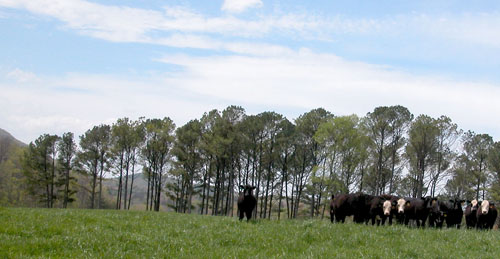While the California dairy cow that tested positive for bovine spongiform encephalopathy, or mad cow disease, made national headlines this week, University of Georgia livestock and food safety experts say the real story is how well the nation’s food safety system worked.
Bovine spongiform encephalopathy, or BSE, “was identified in a dairy cow, and the cow never entered the food supply,” said Judy Harrison, a professor and UGA Cooperative Extension food safety specialist in the College of Family and Consumer Sciences. “It is not passed through milk, and we have many tests in place in this country to make sure problems like this are not a threat to the food supply. … This case is a good example to consumers of how the system works to keep their food safe.”
BSE first made headlines in the late 1980s with a mass outbreak in Great Britain. It’s a degenerative disease caused by small proteins called prions that attack the cow’s central nervous system. Prions are less complex than viruses but are still able to reproduce their genetic material and damage cells.
The disease caused herds of cows in Britain to act erratically and then gradually lose most of their motor function, leading to the lay term “mad cow disease.”
After eating beef that was tainted with these prions, some humans also contracted the human form of the disease.
Since the late 1980s, the USDA, the FDA and the beef industry have completely changed their practices regarding the handling of cattle and beef bound for human consumption, said Ronnie Silcox, an associate professor of animal science in the UGA College of Agricultural and Environmental Sciences.
These changes have made it nearly impossible for a tainted cow to make it to a processing facility — much less make it onto a family’s dinner table.
The disease spread through Great Britain’s cattle supply so quickly because of the use of animal feed made from beef byproducts. The practice of feeding mammalian byproducts to cattle has since been banned, and beef processors now remove the spine and brain from beef carcasses before they are processed.
Any cow that cannot walk into a processing facility is suspected of having BSE, excluded from the food supply and tested. Farmers and stockyards now routinely test older and sick cows for BSE, Silcox said.
Although millions of older and sick cows have been tested since these safety practices have been put in place, only four U.S. cows have tested positive for the disease—one cow imported from Canada to Washington state, one in Texas, one in Alabama and the recent dairy cow in California, Silcox said.
No cow under 30 months of age has ever been found to be carrying the disease, he said.
“When you go into the grocery store, all the steak and roasts there come from relatively young cow,” he said. “We have never seen a cow test positive for BSE who was less than 30 months old.”
The precautions taken by the USDA, FDA and the international food safety and agriculture communities have nearly eradicated BSE from cattle populations over the last 20 years, Silcox said.
With only 29 cases of BSE reported worldwide in 2011, the specter of the disease is now one of its greatest impacts.
This week’s announcement disrupted the cattle futures market, but it later rebounded. “This one wasn’t even going to end up in the food supply, and the beef futures market still dropped, but of course any news about beef can disrupt the futures market,” Silcox said.
The case will not affect beef exports to trade partners like Mexico or Japan that already require imported beef to be harvested before the cows reach 30 or 20 months of age, Silcox said.
What you should know about BSE:
— The USDA announced a positive test result for BSE in a central California dairy cow on April 24 as part of its targeted surveillance program to test cattle for bovine spongiform encephalopathy.
— According to the USDA, the carcass of the animal is being held under State authority at a rendering facility in California and will be destroyed. It was never presented for slaughter for human consumption, so at no time presented a risk to the food supply or human health.
— The bottom line for consumers remains the same: U.S. beef is safe because of multiple, interlocking safeguards instituted over the past two decades. The BSE agent is not found in meat like steaks and roasts. It is only found in central nervous system tissue such as the brain and spinal cord, which are not allowed for use in food products.
— BSE is fast approaching eradication worldwide. According to the World Organization for Animal Health (OIE) there were only 29 cases of BSE worldwide in 2011, which is a 99 percent reduction since the peak in 1992 of more than 37,300 cases.
This is only the fourth case of BSE in the U.S., compared to more than 37,000 cases in the United Kingdom alone during peak occurrence in 1992.
— USDA’s ongoing BSE surveillance program tests approximately 40,000 high-risk cattle annually, bringing the total of tested animals to more than 1 million since the program began. A scientific analysis of seven years of surveillance data found the estimated prevalence of BSE in the U.S. to be less than one infected animal per 1 million adult cattle.
— USDA Public Health Veterinarians examine every single animal before processing and condemn those with any signs of illness. Animals most likely to have BSE are older animals either unable to walk or showing signs of neurological disease. Such animals are banned from the human food supply.




